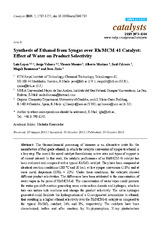Synthesis of Ethanol from Syngas over Rh/MCM-41 Catalyst: Effect of Water on Product Selectivity
Autor
López, Luis
Velasco, Jorge
Montes, V.
Marinas, Alberto
Cabrera, Saúl
Boutonnet, Magali
Järås, Sven
Editor
MDPIFecha
2015Materia
EthanolSyngas
Rh/MCM-41 catalyst
Water vapor
METS:
Mostrar el registro METSPREMIS:
Mostrar el registro PREMISMetadatos
Mostrar el registro completo del ítemResumen
The thermochemical processing of biomass is an alternative route for the
manufacture of fuel-grade ethanol, in which the catalytic conversion of syngas to ethanol is
a key step. The search for novel catalyst formulations, active sites and types of support is
of current interest. In this work, the catalytic performance of an Rh/MCM-41 catalyst has
been evaluated and compared with a typical Rh/SiO2 catalyst. They have been compared at
identical reaction conditions (280 °C and 20 bar), at low syngas conversion (2.8%) and at
same metal dispersion (H/Rh = 22%). Under these conditions, the catalysts showed
different product selectivities. The differences have been attributed to the concentration of
water vapor in the pores of Rh/MCM-41. The concentration of water vapor could promote
the water-gas-shift-reaction generating some extra carbon dioxide and hydrogen, which in
turn can induce side reactions and change the product selectivity. The extra hydrogen
generated could facilitate the hydrogenation of a C2-oxygenated intermediate to ethanol,
thus resulting in a higher ethanol selectivity over the Rh/MCM-41 catalyst as compared to
the typical Rh/SiO2 catalyst; 24% and 8%, respectively. The catalysts have been
characterized, before and after reaction, by N2-physisorption, X-ray photoelectron spectroscopy, X-ray diffraction, H2-chemisorption, transmission electron microscopy and
temperature programmed reduction.

